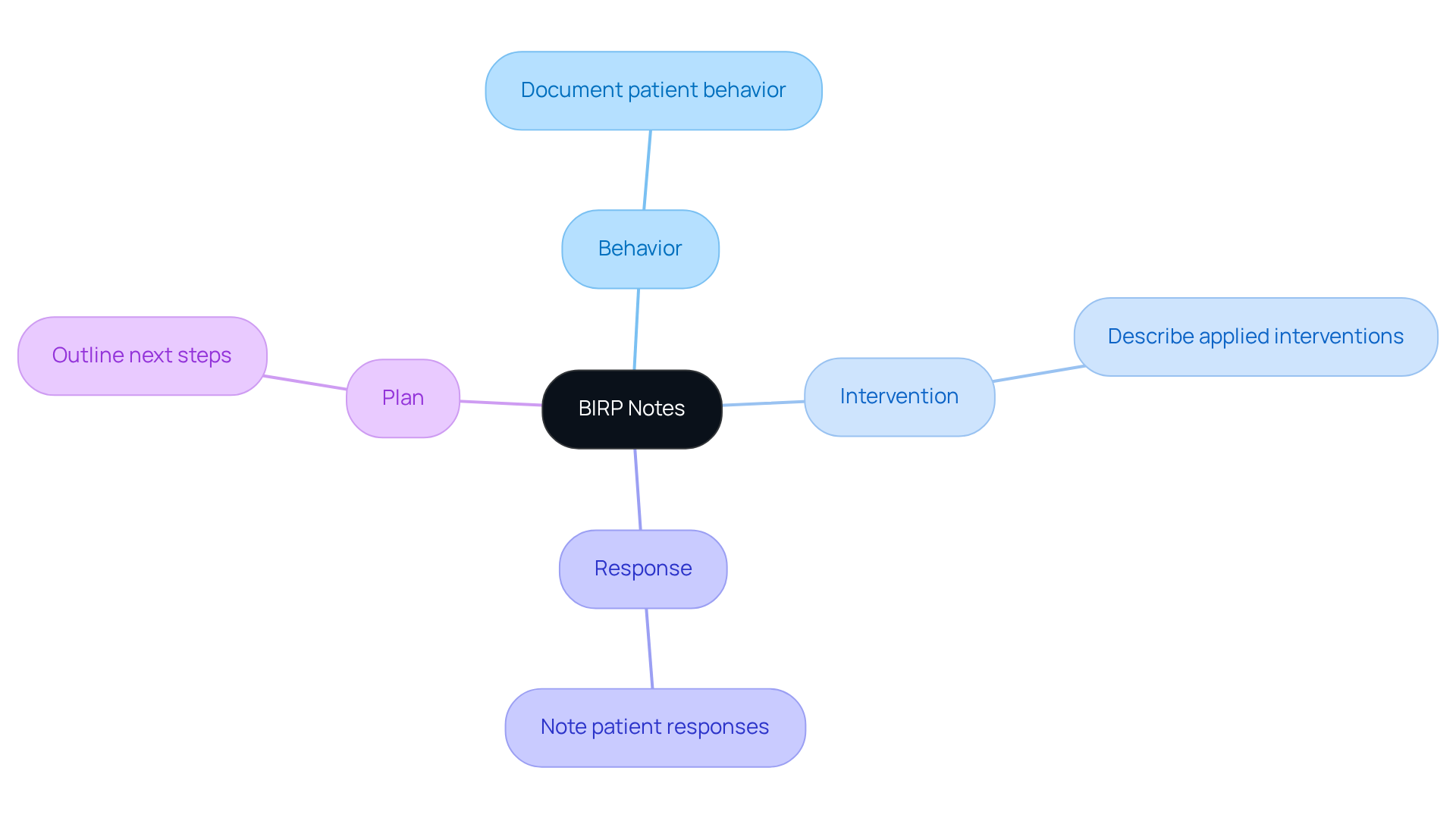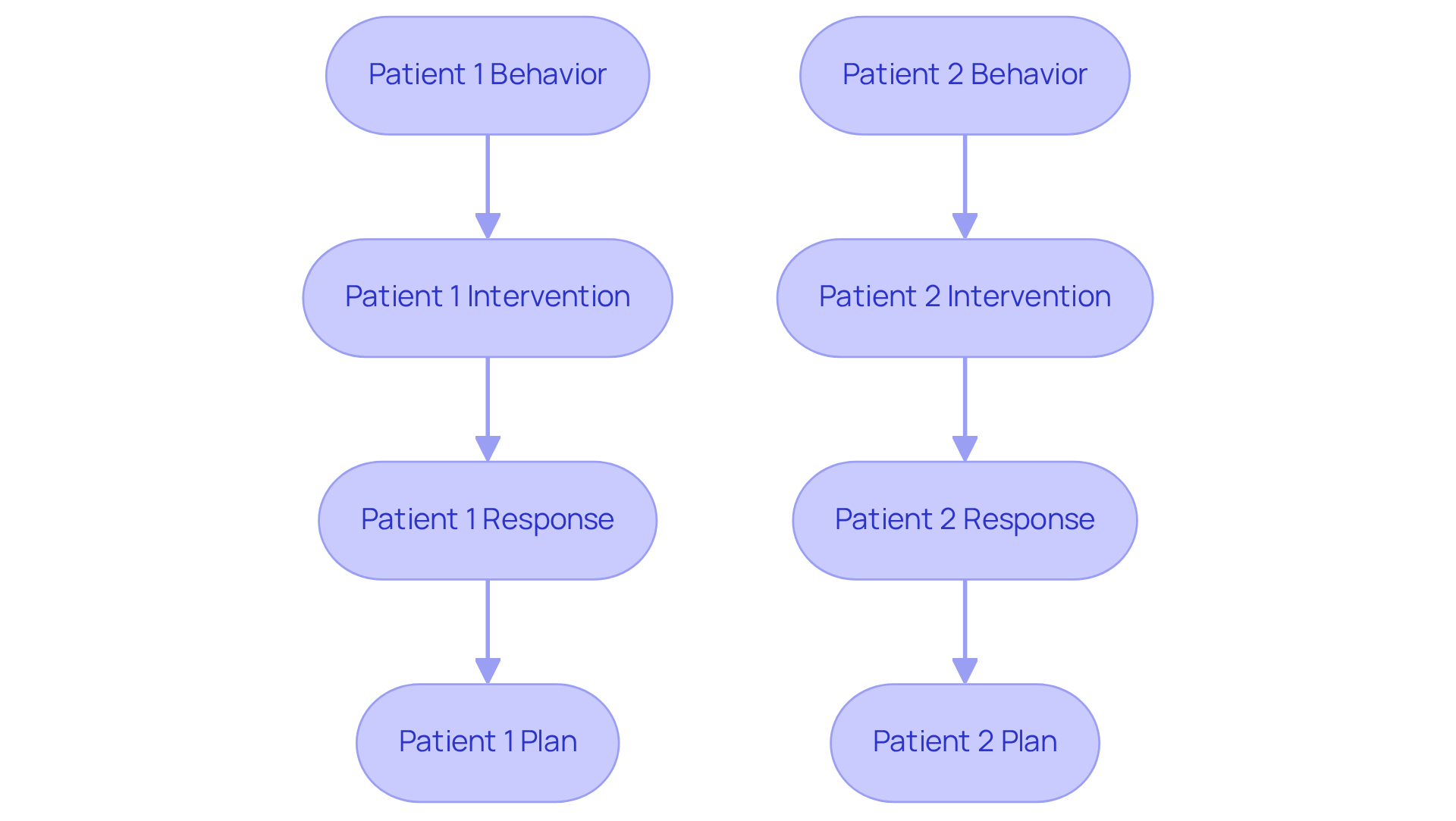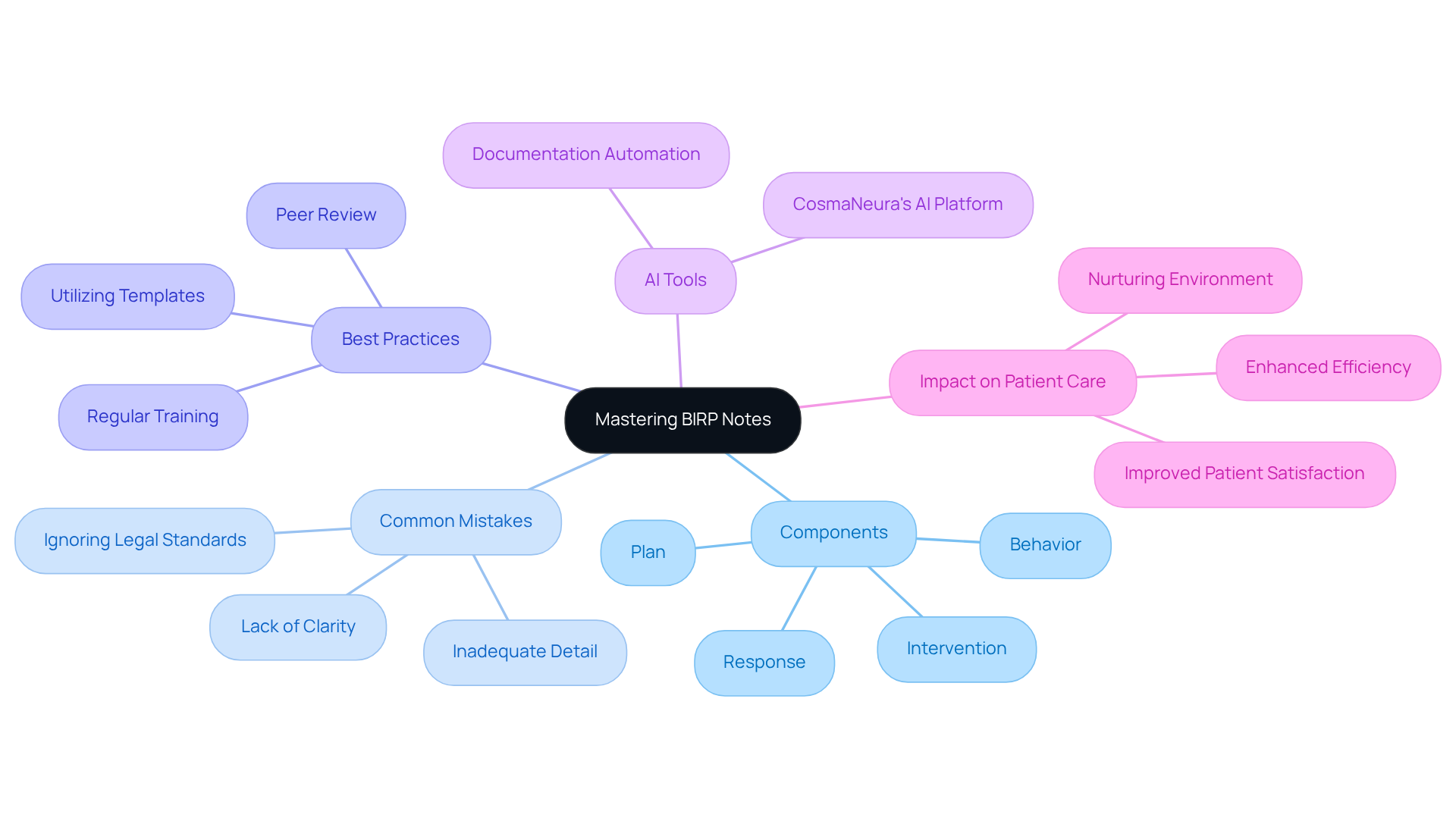Overview
This article addresses the emotional challenges that healthcare providers often face, particularly in the realm of documentation. Writing effective BIRP notes is essential for not only recording therapy sessions but also for alleviating the stress associated with administrative tasks. By utilizing the structured format of BIRP notes—Behavior, Intervention, Response, and Plan—therapists can enhance clarity and efficiency in their documentation.
Have you ever felt overwhelmed by the administrative demands of your role? The burden of paperwork can significantly impact the quality of patient care. By streamlining documentation through BIRP notes, therapists can focus more on their clients, ultimately improving outcomes.
Imagine the relief of reducing your administrative workload while still providing comprehensive care. BIRP notes not only simplify the documentation process but also contribute to better patient relationships. This approach fosters a nurturing environment where therapists can thrive, and patients can feel genuinely supported.
We encourage you to explore the benefits of implementing BIRP notes in your practice. By embracing this structured format, you can make a meaningful difference in your work and the lives of those you serve. Together, let’s enhance our approach to patient care and reduce the stress that often accompanies our vital roles.
Introduction
In the intricate landscape of healthcare, therapists face the emotional challenge of providing compassionate care while navigating the heavy demands of documentation. It’s not just about delivering effective treatment; it’s also about ensuring that administrative tasks don’t overshadow meaningful client interactions.
This article delves into the essential elements of BIRP notes, offering a comprehensive guide to streamline documentation practices. How can therapists balance the need for thorough records with their desire to prioritize patient care? By exploring practical examples and strategies, we aim to illuminate the path toward efficient and impactful documentation.
Imagine a world where documentation enhances, rather than hinders, the therapist-client relationship. This piece seeks to support you in achieving that balance, enhancing both therapist and client experiences.
CosmaNeura: Streamline Your BIRP Notes with AI-Powered Efficiency
In the demanding world of healthcare, therapists often face emotional challenges that can impact their ability to provide the best care. The burden of administrative tasks can weigh heavily, pulling focus away from meaningful client interactions.
CosmaNeura's AI platform offers a compassionate solution by automating and simplifying the process of writing therapy records. Imagine being able to concentrate more on your clients rather than getting lost in paperwork. With AI technologies like real-time transcription and summarization, you can ensure that your documentation is not only efficient but also aligned with best practices.
This innovation is particularly crucial in addressing the prevalent issue of physician burnout. By significantly reducing the time spent on note-taking, it alleviates the administrative burden that healthcare professionals face daily.
Consider this: How much more effective could you be if you could redirect your energy toward your clients? By embracing these capabilities, you enhance the quality of care provided to individuals, ultimately fostering a more supportive environment.
We invite you to explore how CosmaNeura can transform your practice and help you reclaim your focus on what truly matters—your clients.

Understanding BIRP Notes: Key Components Every Therapist Must Know
Cheat sheet sample birp birp notes examples demonstrate that BIRP notes are essential tools in the therapeutic process, consisting of four key components: Behavior, Intervention, Response, and Plan. Understanding these elements can alleviate some of the emotional challenges you face in the cheat sheet sample birp birp notes examples.
- Behavior: This involves documenting the patient's behavior during the session, providing insights into their state of mind.
- Intervention: Here, you describe the interventions applied by the therapist, ensuring clarity on the methods used.
- Response: Noting the patient's response to the interventions is crucial for assessing their progress and engagement.
- Plan: Finally, outlining the next steps in the treatment process helps maintain a clear direction for future sessions.
Recognizing the importance of these components can lead to more effective and meaningful documentation, including a cheat sheet sample birp birp notes examples. It’s not just about paperwork; it’s about enhancing the quality of care you provide. By embracing this structured approach, you can focus more on your patients and less on administrative burdens.

Sample BIRP Notes: Real-World Examples for Effective Documentation
Here are a few sample BIRP notes:
-
Behavior: The patient appeared anxious and fidgety during the session, as noted in the cheat sheet sample birp birp notes examples.
Intervention: Deep breathing techniques, as outlined in the cheat sheet sample birp birp notes examples, were utilized to assist the individual in relaxing.
The patient reported feeling calmer after using the cheat sheet sample birp birp notes examples during the exercise.
Plan: It is important to continue practicing these breathing techniques as outlined in the cheat sheet sample birp birp notes examples in future sessions. -
This is a reference point for the cheat sheet sample birp birp notes examples. Behavior: The patient expressed feelings of sadness and isolation, which can be documented in the cheat sheet sample birp birp notes examples.
Intervention: We discussed coping strategies and the importance of social engagement, using a cheat sheet sample birp birp notes examples as a reference.
The patient showed interest in joining a support group, as noted in the cheat sheet sample birp birp notes examples.
Plan: Let’s review the cheat sheet sample birp birp notes examples for support group options in our next session.

Avoiding Common Mistakes in BIRP Note Writing
Common errors in BIRP documentation can significantly hinder effective patient care. Have you ever felt overwhelmed by the intricacies of documentation? One prevalent issue is the lack of specific behavior documentation, which can lead to unclear records that obscure the client's actual progress. As Vivian Chung Easton observes, 'Inadequate documentation of the client's responses, insights, and progress can obstruct treatment planning and continuity of care.' Furthermore, therapists often find themselves overloading their notes with unnecessary details, which detracts from the key points that matter most in treatment planning. Another critical error is neglecting to update the treatment plan based on the patient's progress, potentially resulting in outdated or ineffective strategies.
To navigate these challenges, therapists should emphasize clarity and conciseness in their records. This means concentrating on pertinent observations and ensuring that each record serves a clear purpose in monitoring client progress. Utilizing a cheat sheet sample birp birp notes examples can help maintain consistency and ensure all necessary details are included. As highlighted in external sources, 'The succinct nature of these records simplifies the documentation process, enabling therapists to dedicate more time to client care and reduce time spent on administrative duties.' By maintaining a structured approach and utilizing templates, therapists can improve the quality of their documentation, ultimately leading to better patient outcomes and more efficient care.
Consider these key solutions:
- Focus on relevant observations.
- Use structured templates.
- Regularly update treatment plans.
By embracing these practices, you can enhance your documentation process, allowing for more meaningful interactions with your clients. Remember, every effort you make contributes to a more effective and compassionate care experience.

Best Practices for Writing Effective BIRP Notes
Using a cheat sheet sample BIRP BIRP notes examples can significantly ease the emotional burden on healthcare providers when writing effective notes. By implementing the following strategies, you can enhance your documentation process and ultimately improve patient care:
- Clarity and Conciseness: Use clear and concise language to enhance readability. This guarantees that anyone examining the records can swiftly understand the crucial details without ambiguity.
- Prompt Documentation: Record observations promptly after the session to capture precise details. Prompt record-keeping aids in preserving the integrity of the information and supports continuity of care.
- Objective Observations: Focus on objective observations rather than subjective interpretations. This approach minimizes bias and provides a factual basis for the client's progress and treatment interventions.
- Routine Assessments: Frequently evaluate and refresh records to represent the patient's advancement and any alterations in treatment strategies. This practice not only keeps the documentation current but also aids in tracking the effectiveness of therapeutic strategies.
- Effective Strategies: Composing every message with the awareness that clients might review them in the future promotes accountability and clarity. Michael Lee, PhD, observes, "you’re not just writing for the sake of compliance," which encourages clinicians to document thoughtfully, ensuring that the records serve both therapeutic and legal purposes.
- Real-World Examples: For instance, a clinician might document a session where a client faced a significant fear, noting the specific interventions used and the client's responses. This not only illustrates the therapeutic process but also provides a clear record for future reference. The significance of recording particular methods and client experiences is emphasized in case studies on individual therapy progress records, such as those illustrated by cheat sheet sample BIRP BIRP notes examples.
- Legal Considerations: Remember that progress records are legal documents. Therefore, maintaining professionalism and accuracy in language is crucial to protect both the clinician and the client. Additionally, it is important to document any advice given regarding medication, even if not prescribed by the therapist, and to maintain confidentiality while documenting interactions with family members in therapy.

Legal Considerations for BIRP Notes: What Therapists Need to Know
Therapists often encounter emotional challenges when navigating the legal landscape surrounding BIRP notes. It’s essential to recognize how these obligations can weigh heavily on your practice and, ultimately, on the care you provide to your clients. By ensuring confidentiality and compliance with HIPAA regulations, you not only protect your clients’ privacy but also foster trust in your therapeutic relationship.
Keeping precise and comprehensive records is another vital aspect of safeguarding against potential legal claims. Have you considered how thorough documentation can serve as a protective measure for both you and your clients? Furthermore, being aware of state-specific regulations regarding record-keeping is crucial in navigating this complex environment.
By following these legal guidelines, you can create a safer space for your practice and uphold the rights of those you serve. Engaging with these practices not only enhances your professional integrity but also reinforces your commitment to your clients’ well-being. Let’s take these steps together to ensure that your practice thrives while providing the highest level of care.

Benefits of BIRP Notes: Enhancing Patient Care and Documentation
The use of BIRP notes offers numerous advantages that significantly enhance patient care and documentation practices, especially when integrated with innovative solutions like CosmaNeura's Agentic Platform.
-
Improved Clarity: BIRP notes provide a structured format that enhances the clarity of documenting patient interactions. This clarity is essential for maintaining continuity of care, as it enables healthcare providers to easily comprehend an individual's history and treatment progress, particularly when clients switch providers or consult multiple specialists.
-
Improved Communication: By standardizing documentation, these records promote better interaction among healthcare providers. This uniformity guarantees that all team members are aligned regarding an individual's treatment plan, which is crucial for coordinated care.
-
Enhanced Responsibility: The organized framework of therapy documentation encourages professionalism and accountability in therapeutic practices. Clinicians are encouraged to document their interventions and the client's responses accurately, which can be vital for legal compliance and quality assurance.
-
Facilitated Monitoring of Progress: Clinical notes allow practitioners to monitor individual progress over time effectively. By recording behaviors, interventions, responses, and future plans, therapists can identify patterns and modify treatment strategies accordingly, ultimately resulting in enhanced outcomes for individuals.
-
Real-World Impact: Consider the case of an individual with bipolar disorder who gained advantages from regular progress notes. These notes facilitated prompt changes in medication and treatment methods, leading to improved mood stability and overall wellness. Statistics indicate that individuals reported a significant enhancement in their mood and stability due to this structured documentation.
-
Interdisciplinary Collaboration: These records also improve communication among diverse healthcare professionals engaged in an individual's care, ensuring that everyone is updated on treatment objectives and advancements. This collaborative approach is essential for comprehensive healthcare management.
In summary, these records simplify documentation and, when used with CosmaNeura's innovative AI solutions, play a crucial role in enhancing the quality of care delivered to individuals. They are not just tools; they represent a commitment to compassionate, coordinated care that truly makes a difference.

BIRP Notes vs. Other Formats: When to Use Each Type
Behavioral health documentation plays a crucial role in supporting therapy sessions. As therapists, we often face the emotional challenge of choosing the right format for our documentation. While formats like SOAP records may be more suited for medical environments, it’s essential to recognize the unique needs of our patients in a therapeutic context.
Consider how using a cheat sheet sample BIRP notes examples can beautifully capture the therapeutic process, allowing us to reflect on our sessions and the progress our patients make. On the other hand, SOAP records serve their purpose well in documenting medical evaluations, ensuring that we meet the necessary standards of care.
Ultimately, the choice of documentation format should be guided by the specific context of each session and the individual needs of our patients. By being mindful of these factors, we can enhance our therapeutic relationships and provide the compassionate care our patients deserve.

Tips for Writing BIRP Notes Faster and More Efficiently
Therapists often face emotional challenges when it comes to documenting their sessions. The administrative burdens can feel overwhelming, impacting the time and energy available for patient care. To help alleviate some of this stress, here are a few strategies that can make writing BIRP notes faster and more efficient:
- Utilize templates to streamline the documentation process. This can save valuable time and ensure consistency in notes.
- Implement voice-to-text technology to reduce typing time, allowing for a more natural flow of thoughts.
- Set aside dedicated time after each session for note-taking. This practice can help maintain consistency and accuracy in documentation.
- Prioritize key points to focus on the most critical aspects of the session, ensuring that the most important information is captured.
By adopting these strategies, therapists can not only enhance their efficiency but also dedicate more time to what truly matters—their patients. Consider trying one or more of these approaches to see how they can benefit your practice.

Key Takeaways: Mastering BIRP Notes for Effective Therapy Documentation
Mastering BIRP notes can feel overwhelming, especially when considering the emotional challenges healthcare providers face daily. Understanding their components, avoiding common mistakes, and implementing best practices is essential, but it can often seem like a daunting task. How do we ensure clarity and efficiency while adhering to legal standards in our records?
By prioritizing these elements, therapists can alleviate some of the administrative burdens that impact patient care. Imagine a world where documentation is streamlined, allowing you to focus more on your patients and less on paperwork. Tools like CosmaNeura's innovative AI platform can help achieve this, transforming the way healthcare providers approach their documentation processes.
This transformation not only enhances efficiency but also leads to improved patient care and satisfaction. By embracing the supportive capabilities of generative AI in healthcare delivery, we can create a more nurturing environment for both providers and patients. Let’s work together to tackle these challenges and enhance the care we provide.

Conclusion
Mastering the art of BIRP notes is essential for therapists who face the emotional challenges of documentation while striving to enhance the quality of care they provide. By understanding the core components—Behavior, Intervention, Response, and Plan—therapists can create structured, clear, and effective records. These records not only serve legal and compliance purposes but also foster better patient outcomes.
Have you ever felt overwhelmed by the demands of documentation? Key insights from this article highlight the importance of clarity, prompt documentation, and the avoidance of common pitfalls in BIRP note writing. The integration of innovative tools, such as CosmaNeura’s AI platform, can significantly streamline the documentation process. This allows therapists to focus more on their clients and less on administrative tasks. Emphasizing best practices and utilizing templates can further enhance efficiency and accuracy in note-taking.
In a rapidly evolving healthcare landscape, embracing these strategies is crucial for improving therapeutic relationships and patient care. By prioritizing effective BIRP documentation, therapists can alleviate their own administrative burdens. This not only contributes to a more compassionate and supportive environment for their clients but also enhances the overall quality of care. The journey towards mastering BIRP notes is not just about compliance; it’s a commitment to delivering the highest standard of care. Are you ready to take the next step in your documentation practice?




